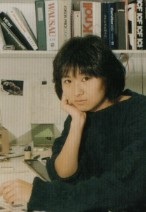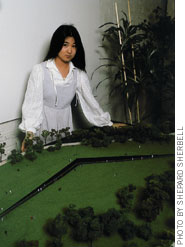林瓔入選“全美女性名人堂”(王波)
全美女性名人堂位于紐約上州一個名叫塞卡福爾斯的小鎮,女性名人堂就坐落在小鎮中心的一座小樓里。展室牆壁四周挂的都是這些女性名人的頭像照片和事跡簡介。新入選的10位女性的事跡簡介被安放在展室中央的活動展架上。 1959年出生的林瓔是迄今最年輕的入選者。看著留著短發、一副學生樣的林瓔,人們很難把她與那個設計出有著深刻內涵的越南戰爭紀念碑的建築設計師聯系起來。簡介上說,當林瓔還是一位21歲的耶魯大學建築專業學生時,她富有想象力的設計就在1420個參賽方案中脫穎而出,成為越南戰爭紀念碑的最終設計方案。她反傳統的設計方案激發了參觀者與紀念碑之間的相互交流。 美國華盛頓特區V形越南戰爭紀念碑是一座打破傳統、前無古人的紀念碑,它已成為藝術史上不朽的標志。長長的、用黑色花崗岩造成的黑牆向地下延伸著,在越戰中陣亡將士的名字按陣亡時間順序排列著,銘刻在兩面相互交叉成V字形的黑色花崗岩的牆上。不斷有陣亡者家屬來到紀念碑前,在黑牆上尋找親人的名字,並用手在名字上觸摸,牆下是獻給親人的鮮花。這座越戰紀念碑自1982年向公眾開放以來,已經成為美國首都華盛頓吸引參觀者最多的紀念碑。 不過,1981年林瓔的設計方案入選後,曾招致強烈反對,引起極大爭議。在紀念碑施工期間,林瓔休學一年,到首都參與施工工程,並應付各種壓力與批評。一年後,她轉到哈佛大學設計研究院,但越戰紀念碑的爭議使她無法專心向學,不到一年即退學回到耶魯大學。1986年,她從耶魯大學建築系畢業,1987年耶魯大學授予她名譽博士學位。 林瓔曾表示,她設計越戰紀念碑時,從“死亡也是一種榮耀”的角度出發,刻意不去研究越南史和越戰史。她的作品憑借藝術、科學和新興技術,改變了許多美國人對世界和他們所處時代重大事件的看法。 林瓔祖籍福建,在俄亥俄州出生。因為在美國出生,她和弟弟都不會說漢語。林瓔出生于書香世家。祖父林長民,民國初年做過司法總長。元配早歿,他娶了兩個姨太太,大姨太生了才貌出眾的林徽音,小姨太生了四個兒子,長子林桓就是林瓔的父親。林桓曾是俄亥俄大學藝術學院院長,其妻是俄亥俄大學亞洲和英語文學教授。 據名人堂的助理主任克里斯蒂娜‧莫爾頓介紹,迄今為止共有兩位華裔女性入選名人堂,除林瓔外,還有1998年入選的著名核物理學家吳健雄博士。 據莫爾頓介紹,全美女性名人堂的宗旨是向那些在藝術、體育、商業、教育、政界、人文學科、自然科學和慈善事業領域作出具有全國或全球性影響的美國卓越女性公民,表示永久的敬意。 (王波) Maya Lin's World
The woman who designed the extraordinary Vietnam Veterans Memorial in Washington, D.C., is bringing her skills and sensibilities to Corporate America. Maya Lin infuses her architecture for American Express, Principal Financial Group, and Aveda cosmetics, her furniture for Knoll and her residences for former CEOs with the same calm introspection and quiet emotion she brings to her monuments. In her use of natural materials--rock, wood, water--her respect for the land, her use of flexible space, and her integration of East and West, Lin is very definitely of the moment. If the most famous architect of our day, Frank Gehry, is all about gargantuan, computer-shaped, titanium temples to high technology, then Lin is about restraint, the environment, organic materials, and a new kind of architectural humanism. Lin is the anti-Gehry. Lin's monuments are designed to be touched and to generate emotion. ''Active participation involves the viewer in a direct and intimate dialogue with the work,'' says Lin in her new book, Boundaries. Touch the names on the Vietnam Veterans Memorial and you remember loved ones who died in the war. Touch the water flowing over the Civil Rights Memorial and it ripples over the names of those killed in the struggle. Lin's father, who came to the U.S. from China in the late 1940s, was a potter. He taught his daughter how to sculpt. As an undergrad at Yale University, Lin shaped the Vietnam memorial in mashed potatoes in the dining hall. Even today, she doesn't use 3D software to design, preferring pen, paper, and models. Lin designs her monuments, landscapes, houses, and furniture to reflect rolling hills and open, flowing spaces. Her architecture and sculpture don't dominate but integrate with their surroundings. They are calm. They don't shout. Lin's latest corporate work reflects the themes she has developed in her 20-year career. Her Winter Garden for American Express has a water wall that offers soothing sounds and a floor that undulates like a hillside meadow. The flowing spaces in her apartment for Peter Norton, founder of software maker Norton Utilities, can be zoned off with sliding partitions, much like a traditional Japanese house. Her wall in the lobby of the headquarters of the Principal Financial Group has a creek running through it, an open invitation to feel the flowing water. Maya Lin, 41, offers an alternative aesthetic to the big, brassy, look-at-me architecture of our wildly prosperous era. It may be time for America to listen to her--again. Sculpted Forms How She Sees It Let There Be Light Maya Lin One of the rare few who has managed to forge a path in both art and architecture, Maya Lin is a sculptor, architect, designer, and craftswoman. Lin has consciously resisted divisions between architecture and design or fine and applied art. Lin's parents are originally from Beijing and Shanghai but moved to Athens, Ohio in 1949. Her mother taught literature and her father taught art at Ohio University, Lin who grew up surrounded by art and literature was constantly delving into new projects and books. She credits her Asian-American heritage as the source of her refusal to separate East/West influences, reason and intuition, and left and right brain. Lin attended Yale University, and received a Bachelor of Arts degree in Architecture in 1981, and a Master of Architecture from Yale's School of Architecture in 1986. The following year, she opened a studio where she could complete art and architecture projects designed for locations throughout the country. Influenced by the Earth Artists of the 60's and 70's, Lin brings a highly contemporary perspective to the landscape by merging the rational order of high technology with the transcendental and irregular forms of nature. She has continuously addressed the notion of landscape and topology in her work. She refers to the Women's Table (Yale University, 1993) and the Civil Rights Memorial (Southern Poverty Law Center, Montgomery, Alabama 1988-1993) as water tables-with the water and the historical information they offer, welling up as if from the earth itself. One of the primary images she had for the Vietnam Veterans' Memorial (The Mall, Washington, D. C., 1981) was tearing at the earth. Lin is strongly concerned about the environment, and incorporates recycled, living, or natural materials in her work such as in The Wave Field (University of Michigan, 1993-4), a sculpture of a molded field of grass. Her concerns led her to serve on the Board of Energy Foundation as well as on the National Advisory Board to the Presidio Council in San Francisco. Recently, Lin began collaborating with The Natural Resources Defense Council and Banana Kelly to design a paper recycling center for the South Bronx in New York. She also serves on the Boards of The Southern Poverty Law Center's Teaching Tolerance project, the Kennedy Museum of Art, at Ohio University, and Studio in a School in New York. This work comes from her firm support of education and the arts. The American vision Lin presents in her sculpture and architecture, is one of historic outcomes merged with both the process and the legacy. Her many awards include the architecture prize from the American Academy of Arts and Letters for designing buildings like the Langston Hughes Library (Clinton, Tennessee, 1999) and the Museum for African Art (SoHo, New York, 1984-92). She has also received the Presidential Design Award, The American Institute of Architects Honor Award, and the Henry Bacon Memorial Award; and Honorary Doctorates in Fine Arts from Harvard, Yale, Brown, Smith, and Williams. Lin lives in New York with her husband Daniel Wolf, and their two young children. She is currently working on sculpture installations for the Rockefeller Foundation Headquarters and the Cleveland Public Library. Maya Lin's 'Clear Vision' In the finely crafted documentary about the memorial's architect, "Maya Lin: A Strong Clear Vision," we are reminded of the chasm the memorial created between those who saw it as a salve and those who saw it as a salvo. And we learn about the life and work of one of the most provocative artists in 20th-century America. The film won the Academy Award for Best Achievement in Feature Documentary in 1995, but is only now being shown commercially in Washington. Directed by Freida Lee Mock ("Rose Kennedy: A Life to Remember") and produced by Mock and Terry Sanders, it follows Lin from the time she first heard about the national competition as a Yale undergraduate to the 10th anniversary of the memorial in 1992. In those 12 years, we see Lin mature. But we are left with the sense that from the very beginning she knew exactly what she wanted to do. Hers was a radical notion for a monument on the mall -- a sunken wall, cold, horizontal and black, etched with the names of more than 57,000 dead soldiers. At the announcement ceremony in the spring of 1981, Jan Scruggs, a veteran and prime force behind the memorial, leaned over the microphone in front of a shy, giggling Lin and said, "I'd like to point out that really the finest architects in the country and some of the highest-priced architecture firms in the country did enter this competition. And they lost." They lost to a 20-year-old kid from Athens, Ohio, the daughter of Chinese immigrants. Maya Lin's story is the stuff that American dreams, and documentaries, are made of. Using old footage, Mock revisits the divisive debate which included vehement opposition from the likes of media personality-turned-presidential-candidate Pat Buchanan. As people lashed out at her design at a U.S. Commission of Fine Arts hearing, Lin sat in the room neither smiling nor frowning -- stoic, quiet, like a granite wall. She seemed so young, yet so unwavering in her conviction. "Imagine the courage that took," said architectural historian Vincent Scully, Lin's professor at Yale. "The fiber. The word for Maya is courage. And effrontery." At one point she says, "An artist struggles to retain the integrity of a work so that it remains a strong, clear vision." Lin opines on-camera often -- too often -- in the film. The narrative of her life and work is interspliced with shots of her sitting on a stool talking about her work or in a turtleneck hunched over her drafting table, gooseneck lamps overhead, cold drink nearby. Though she speaks eloquently and convincingly about her creations, the power of the movie, as the power of her art, is when things are shown and not explained. For example, she tells us that when she designed the Vietnam memorial, "I really did mean for people to cry." In the next scene, we see men standing at the black wall, crying. It is a power-charged moment. The Vietnam memorial led to more commissions for Lin. She poured 43 tons of broken glass into spaces at the Wexner arts center in Columbus, Ohio. Morris Dees, founder of the Southern Poverty Law Center in Montgomery, Ala., asked Lin to design a Civil Rights Memorial. She read up on civil rights activities -- many events had occurred before she was born. Then she tumbled onto a resonant phrase in Martin Luther King's "I Have a Dream" speech. King said those who fought for racial equality would not be satisfied "until justice rolls like waters and righteousness like a mighty stream." This passage became the inspiration for a circular fountain in Montgomery that chronicles, like a sundial, the turning points of the civil rights movement. One of the most moving segments of the film occurs when aged, stalwart Rosa Parks is led to the monument. With a steady hand, she runs her fingers across the words "Rosa Parks arrested for refusing to give up her seat on a bus to a white man -- Montgomery, AL." Little time is spent on Lin's private life. Her mother taught English at Ohio University in Athens. Her father was dean of the arts school. She lived in a sunny, orderly house full of her father's ceramics. Her back yard was surrounded by woods. She had an idyllic upbringing. "I was one of those disgusting little kids who really loved school," she says. Her family had a great respect for creativity. What makes this documentary so forceful is its great respect for Lin's creativity. Near the end of the film, it's a dreary, drizzly Veterans Day, 1992. A close look at her face shows she's hardened over the years. There are still hints of the joyous, young girl from Yale, but she's been changed, been through the stone cutter, been honed and shaped into something mature and lasting that can coexist with nature. The man who introduces her says the Vietnam memorial is a space where the living and the dead can meet. Then he gets choked up and backs away. She steps up to the podium and receives a standing ovation. She smiles and apologizes to the crowd. "I didn't really have a speech prepared. I'm not very good at these things at all. Oftentimes, I just let the works speak for themselves." She says a few more things. A bugler plays taps. Men are crying. "Maya Lin: A Strong Clear Vision" is not rated. ARTIST HERO:
MAYA LIN Dedicated, persistent, focused, and modern -- all of these words describe Maya Lin. Maya was born on October 5, 1959. She designed the Vietnam Veteran's Memorial, the Civil Rights Memorial, Groundswell, The Wave Field, and many other amazing and influential architectural projects. In addition to being an architect, Maya is a sculptor and an artist. She is also the author of a book entitled, Boundaries. Both of Maya's parents were art-oriented. Her mother was a poet and her father made ceramics. Both of them taught courses at Ohio University in Athens, Ohio. She was the co-valedictorian of her high school class and had little trouble getting into Yale. It was there that she enrolled in a class in burial architecture taught by Professor Andrus Burr. He asked her to enter the contest to design a memorial for Vietnam veterans. Maya Lin was a senior at Yale when her design was chosen as the winner of the contest. The design itself was the object of much controversy. Opponents of the design called it "a black scar in the earth," and were angry that a memorial for Vietnam veterans was designed by a person of Asian origin. After the vitriolic controversy surrounding the design, many of the people who went to see the memorial were surprised at how well the elegant yet simple monument honored those who had died. Maya's winning design consists of two long black granite walls, intersecting at a 125 degree angle. Each wall is 246.75 feet long and 10.1 feet tall. The walls taper down to a point at each end. The walls contain the 58,175 names of those who died or are listed as MIA in Vietnam during the war. The walls themselves are carved into the earth, so that people descend into the memorial. Maya Lin is a hero because when her design was under heavy fire from the government and the press, she held her ground, ensuring that a beautiful and moving memorial would be built for all to touch and see. Written by Tom |




